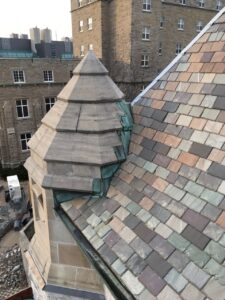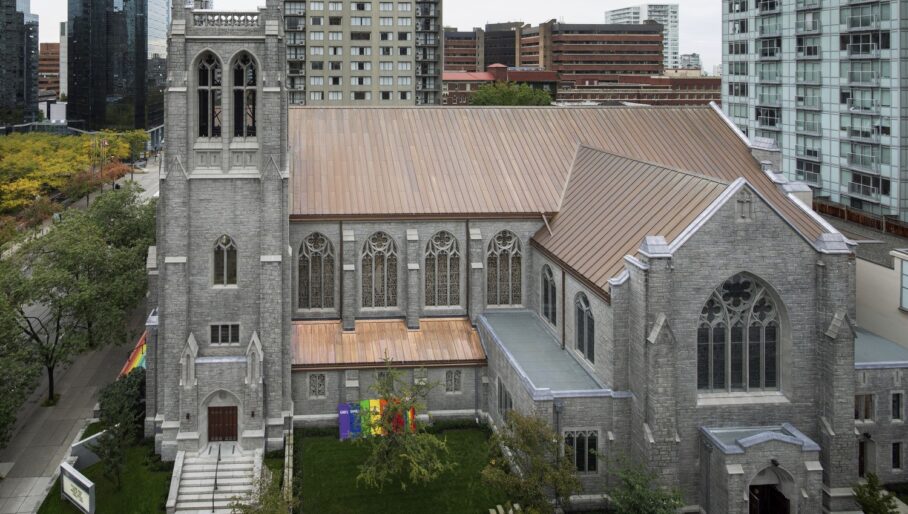From slate to clay, concrete to sheet metals, and cedar to asphalt, roofing materials today are selected for a variety of reasons, including durability, cost, embodied energy, ease of maintenance and constructability. Historically, however, architectural style and character bore more weight when determining materials and heavily influenced the design process.
“Roofs on historic buildings were intrinsic to the original architecture—including massing, texture and colour,” explains Glade Schoenfeld, Principal at RJC Engineers. “The form of the roof needed to be both functional and aesthetic, but often the aesthetic aspect of the design made the roofs difficult to access, which necessitated the use of highly durable materials.”
Popular, durable roofing materials included copper, zinc, and raw slate. Though costlier to source and install than other options, these materials were known to last 100 years in excellent condition while contributing significantly to the architectural expression of the building. Today they are found in the rooflines, domes, parapets, balustrades, gables, and other ornamentations of historic buildings, and much of Schoenfeld’s work involves conserving these treasures to be functional yet still enjoyed and appreciated for generations to come.
“Heritage roofs are like any other Character Defining Element (CDE) on a historic building,” he says. “When the roofing is identified as a CDE, the preferred approach is to conserve, preserve or restore depending on the material and the condition of the roof. While copper and zinc can be restored because the tools, materials and trade knowledge remain available, slate is a little different. It is such a durable material that it can be reused, so preservation is the preferred approach.”
Each material also responds differently to environmental influences, and as such, some heritage roofs age differently than others. For instance, as copper ages, it forms a patina that protects it and adds to the overall aesthetic. Depending on the environmental conditions the roof is exposed to, the patina can range in colour from copper-green to copper-bronze.
“Copper’s also an inhospitable environment for organic growth,” Schoenfeld says. “Moss and other organics will not grow on the surface of copper and zinc roofing materials. The durability, long service life and recyclability of copper and zinc make them environmentally sustainable materials.”
Another benefit of working with copper is the fact that it’s highly workable. According to Schoenfeld, it can be used as sheets to form panels and tiles, it can be hammered and rolled to create texture and curvature, and it can be soldered and folded to form watertight seams.
Slate tiles, on the other hand, are a different beast altogether. They are shingled to shed water—and while highly durable with a very low water absorption index, aesthetically slate does not change colour or form a noticeable patina. A slate roof can be built with modern waterproofing materials beneath it, without changing the original architectural appearance.
“Slate tiles remain virtually unchanged over time and won’t deteriorate due to weather exposure,” he says. “Slate tiles are also 100 per cent reusable, making the material a one-time investment for a building. Original slate tiles can be reused if removed and stored with care during a roof conservation project.”
 Determining the right approach
Determining the right approach
For heritage building owners, knowing when and how to address an aging roof system begins with having knowledge of the original materials and the best practices used to restore them. Unlike modern commercial buildings, historic roofs require an approach that puts conservation, restoration, and preservation first.
“The use of hydrocarbons has taken over the roofing industry,” says Schoenfeld. “New roofs using modern materials generally have an expected service life of 25 to 35 years and are very difficult to reuse or recycle. Not the case with heritage roofs.”
Before embarking on a conservation project, Schoenfeld says there needs to be a Statement of Significance (SOS) prepared that identifies the character defining elements of the building. The SOS is then used to inform the Conservation Plan (CP), which provides direction on the conservation approach for each CDE. Once the conservation approach for each roof element is defined, the design will follow the typical design process.
For more information, visit rjc.ca or contact Glade Schoenfeld directly at gschoenfeld@rjc.ca.






